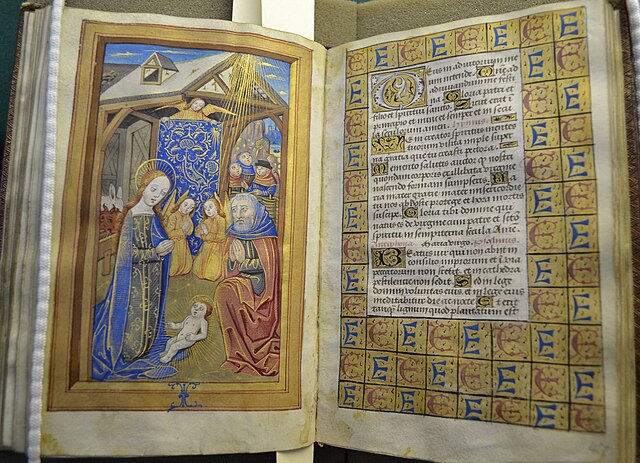The term Labours of the Months refers to cycles in Medieval and early Renaissance art depicting in twelve scenes the rural activities that commonly took place in the months of the year. They are often linked to the signs of the Zodiac, and are seen as humankind's response to God's ordering of the Universe.
Illustration from Très Riches Heures du Duc de Berry, 1412-16, by Pol and Hermann de Limbourg, representing the month of August and depicting, in the foreground, the Nobility riding out to hunt with falcons while in the midground, the harvest takes place and the workers cool off in the river. One of the Duc's many castles, Étampes, completes the scene. Illumination on vellum, 22,5 x 13,6 cm
The Month of September from the Fontana Maggiore in Perugia (c. 1275), by Nicola and Giovanni Pisano, shows the treading of grapes.
Chartres Cathedral, the months of December, January and February
Books of hours are Christian prayer books, which were used to pray the canonical hours. The use of a book of hours was especially popular in the Middle Ages, and as a result, they are the most common type of surviving medieval illuminated manuscript. Like every manuscript, each manuscript book of hours is unique in one way or another, but most contain a similar collection of texts, prayers and psalms, often with appropriate decorations, for Christian devotion. Illumination or decoration is minimal in many examples, often restricted to decorated capital letters at the start of psalms and other prayers, but books made for wealthy patrons may be extremely lavish, with full-page miniatures. These illustrations would combine picturesque scenes of country life with sacred images.

Opening from the Hours of Catherine of Cleves, c. 1440, with Catherine kneeling before the Virgin and Child, surrounded by her family heraldry. Opposite is the start of Matins in the Little Office, illustrated by the Annunciation to Joachim, as the start of a long cycle of the Life of the Virgin.
An early 15th-century French book of hours (MS13, Society of Antiquaries of London) open to an illustration of the 'Adoration of the Magi'. Bequeathed to the Society in 1769 by the Revd Charles Lyttleton, Bishop of Carlisle and President of the Society (1765-8).
Example of a more affordable and thus more common book of hours: Excerpt from a "simple" Middle Dutch book of hours. Made in the 2nd half of the fifteenth century in Brabant.
Even this level of decoration is richer than those of most books, though less than the lavish amounts of illumination in luxury books, which are the ones most often seen reproduced.







